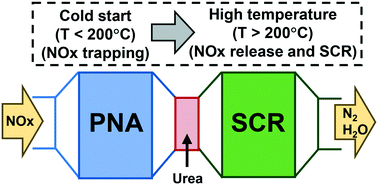From metal-supported oxides to well-defined metal site zeolites: the next generation of passive NOx adsorbers for low-temperature control of emissions from diesel engines
Abstract
Different zeolite-based materials have been commercialized as efficient catalysts for the selective catalytic reduction (SCR) of NOx using ammonia as a reducing agent. However, these materials show limited catalytic activity at low exhaust temperatures, which are achieved during warming up of the engine (“cold start” conditions). To overcome this limitation, inclusion of a passive NOx adsorber (PNA) as a new component of the emission-control system has been proposed. The PNA can adsorb NOx species during the cold start at low temperatures and, afterwards, permits their release at higher temperatures, at which point the SCR catalyst can complete the NOx reduction. In this review, we discuss the most relevant PNA materials, including those based on amorphous oxides and zeolites, together with fundamental understanding of the NOx adsorption–desorption mechanisms associated with PNA materials. The ability to control the dispersion and nature of the metals, the reducibility of the amorphous oxide supports, or the physicochemical properties of the zeolites can be key parameters in the design of more active and stable PNA materials.

- This article is part of the themed collections: Selective catalytic reduction of NOx and Reaction Chemistry & Engineering Emerging Investigators


 Please wait while we load your content...
Please wait while we load your content...